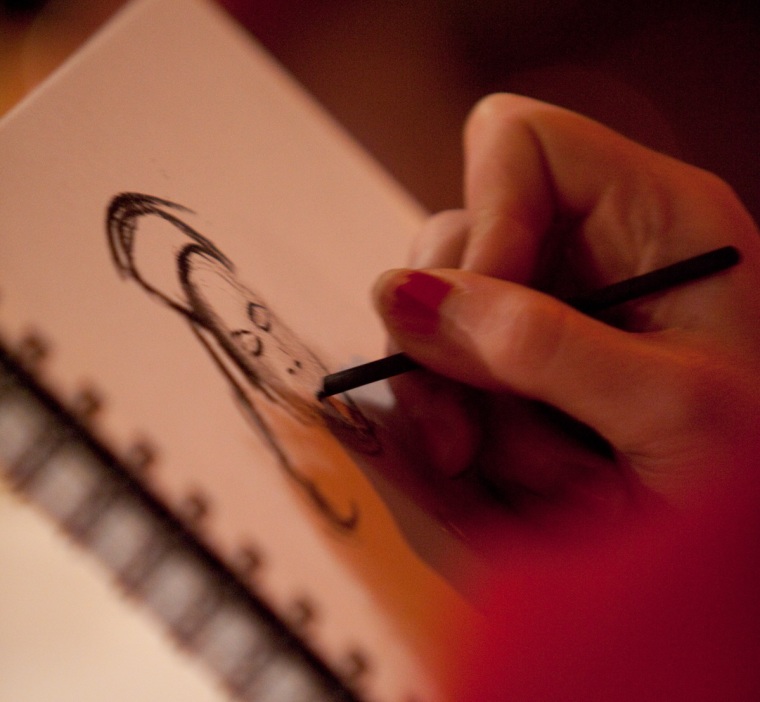
Time to start drawing! In this lesson, students will learn about various drawing supplies and then draw a “before” picture. Put the before drawing away until a later time, then draw the same pictures again – it’s fun to see how much the artwork has improved. If using this lesson in a classroom, it’s a good one to begin with as it helps give the teacher a better understanding of each student’s ability level.
SUPPLIES:
Drawing pencils are different from the pencils you find in the school supply section of the store. These pencils do not have an eraser on the top, and their leads vary in hardness. The softer the lead, the darker the lines; the harder the lead, the lighter the lines. Pencils with softer leads are marked with the letter “B”, while pencils with harder leads are marked with an “H”.
Drawing paper is thicker and heavier than regular computer paper. However, computer paper is less costly and a good paper to practice on.
Pink Pearl Eraser – Pink pearl erasers have a nice tip if you have a small area you need to erase, and they do the job cleanly with no smudges. Use the pink pearl instead of the eraser on top of your pencil when you start drawing – most of these erasers leave marks across the paper.
Kneaded eraser – These erasers are just plain fun! You can sculpt them into almost any shape or pull them apart and squish them back together again. For this reason, they are called kneaded erasers – you can “knead” them just as you would knead bread dough. The purpose of this is actually to clean the eraser – when one part of it has graphite on it, simply knead it by folding it over and over on itself, and it will become clean again. This eraser is a great tool when you need to just “pick up” some of the pencil (or graphite) from your paper in order to lighten it.
There are eight things to know before you start drawing:
1. Drawing is seeing.
2. Drawing is fun!
3. Drawing requires concentration.
4. Drawing is fun!
5. Drawing involves planning.
6. Drawing is fun!
7. Drawing isn’t a race.
8. Drawing is fun!
Okay, that’s really only five things, but they’re all important.
1. Drawing is seeing. Have you ever imagined a picture in your mind, but when you tried to draw it on paper, it didn’t come out the way your thought it should? Because it’s often difficult to draw something from memory or from our imaginations, it’s a good practice to draw from real life or reference pictures. By doing so, we can see where things are placed and how they line up with the other parts of the object we’re drawing. For example, we know that a face has two eyes, but did you know that the iris, or colored part of the eye, is a circle that goes from the top lid to the lower lid? Did you realize that the pupil is also a circle? Or that almost all eyes show a catchlight – a white spot where light is reflecting off of the eye? You’ll find that the more you practice seeing how the shapes and lines come together, the better your drawings will be.
2. Drawing requires concentration. Unless you’re just doodling in your notebook when you should be listening to your teacher, you’ll find that drawing requires your attention and concentration in order to do it well. This means that talking in class should be at a minimum so that all students have an opportunity to think about their art and do their best work. Talking and distractions interrupt one’s thoughts, and it can be difficult to finish well.
3. Drawing involves planning. Before you draw, consider first what you are going to draw, how big you are going to draw it, and where on the paper it will go. If you are in a hurry and just start drawing, you might make the picture too large so it runs off the edges, or you might make it so small it doesn’t fill the paper. Thinking through your work to the final drawing means less erasing as you go along.
4. Drawing isn’t a race. I’ve never seen a racecar shaped like a pencil, have you? That’s because pencils aren’t for racing – they’re for drawing – so take your time! Some people draw quickly, some very slowly, and that’s fine! Take the time you need to make your artwork its best.
5. Most importantly, drawing is fun! If ever drawing becomes tedious or frustrating, it’s time to put your pencil down and take a break. Go back to it when you’re ready.
EXERCISE:
This first exercise is a fun one. Find a picture to copy (line drawings and coloring pages work really well) and start drawing. You may not have time to draw all of them – remember, you don’t need to hurry. Draw as many as you have time for BY YOURSELF without any help from anyone else. Then, sign your name to your artwork and write the date on the back. Give the drawings to a parent, teacher, or put them away (but don’t forget where!) until until the end of the nine weeks, school year, etc. Then draw the samples again. When you are finished, you will be able to compare your first drawings with your later ones. It’s fun to see how much your drawing has improved!

Please note: Only family-friendly comments will be published.